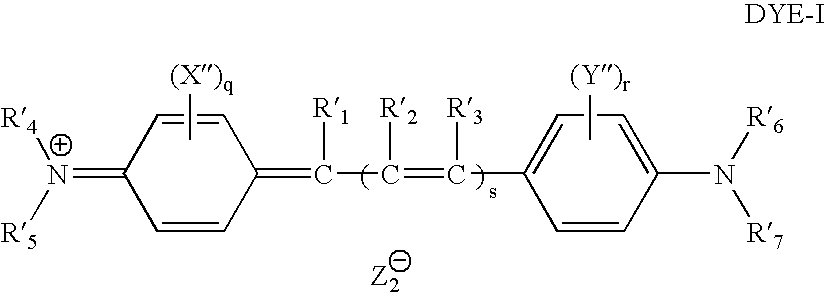Method of making images using fresh processing solution
a processing solution and image technology, applied in the field of making images using fresh processing solution, can solve the problems of undesirable blanket toning, poor water acceptable or ink repellant, and additional problems to overcome, so as to improve work flow and productivity, less contamination of the resulting printing plate surface, and more consistency in image and printing results.
- Summary
- Abstract
- Description
- Claims
- Application Information
AI Technical Summary
Benefits of technology
Problems solved by technology
Method used
Image
Examples
examples
[0320]Unless otherwise indicated, the following materials were obtained from a commercial source such as Aldrich Chemical Company (Milwaukee, Wis.).
[0321]Byk® 307 is a polyethoxylated dimethylpolysiloxane copolymer that is available from Byk Chemie (Wallingford, Conn.) in a 25 wt. % xylene / -methoxypropyl acetate solution.
[0322]Byk® 331 is a polyether modified dimethylpolysiloxane copolymer that is available from Byk Chemie.
[0323]BLO represents γ-butyrolactone.
[0324]Copolymer A represents a copolymer having recurring units derived from N-phenyl maleimide, methacrylamide, and methacrylic acid (41.5:37.5:21 mol %) using conventional conditions and procedures.
[0325]Copolymer B represents a copolymer having recurring units derived from N-phenyl maleimide, methacrylamide, methacrylic acid, acrylonitrile, styrene, and ethylene glycol methacrylate phosphate (12:33:12:34:6:3 mol %) using conventional conditions and procedures.
[0326]Copolymer C represents a copolymer derived from methyl metha...
invention examples 1 and 2
[0380]Lithographic Printing Plate Precursors 1 and 2 were imaged using a Screen PTR4300 platesetter. Internal test pattern C1 was imaged at exposure powers of 45 to 100% in increments of 5% using a drum speed of 1000 rpm. The imaged precursors were processed using the modified Microtec 60 processor containing a fresh sample of Gum N1 as the processing solution that was applied at about 50 ml / ft2 (540 ml / m2) for both development and protective gumming. Gum N1 was maintained at a temperature of 30° C. and processing was carried out at a speed of 1 ft / min. (0.3 m / min.). The used and excess Gum N1 was drained without reuse for disposal. The precursors were evaluated for development time, the exposure energy required to give a clean image, and the exposure energy required to give a clean image, and the exposure energy required to give the best image reproduction. The results are presented in the following TABLE I. The results indicate that both Lithographic Printing Plate Precursors 1 an...
invention example 3
[0381]Lithographic printing plate precursor 3 was imaged with a Kodak® Trendsetter 800II Quantum platesetter using internal test patterns ‘plot 0’ and ‘plot 12’. Exposures were performed at 120 mJ / cm2 at a head power of 9 watts. The imaged precursor was processed using the modified adapted Microtec 60 processor containing a fresh sample of Gum N1 as the processing solution at about 50 ml / ft2 (540 ml / m2) to provide both development and protective gumming. Gum N1 was maintained at a temperature of 30° C. and the imaged precursor were processed at a conveyor speed of 1 ft / min. (0.3 m / min.). Used and excess Gum N1 was drained without reuse for disposal.
[0382]The resulting lithographic printing plate was mounted directly on an A.B. Dick 9870 Duplicator Press (A.B. Dick, Niles, Ill.) that was charged with Van Son Rubber Base black Ink (Van Son Ink, Mineola, N.Y.). An aqueous fountain solution contained about 23.5 ml / liter (3 oz per gallon) Varn Litho Etch142W (Varn International, Addison,...
PUM
| Property | Measurement | Unit |
|---|---|---|
| weight % | aaaaa | aaaaa |
| weight % | aaaaa | aaaaa |
| weight % | aaaaa | aaaaa |
Abstract
Description
Claims
Application Information
 Login to View More
Login to View More - R&D
- Intellectual Property
- Life Sciences
- Materials
- Tech Scout
- Unparalleled Data Quality
- Higher Quality Content
- 60% Fewer Hallucinations
Browse by: Latest US Patents, China's latest patents, Technical Efficacy Thesaurus, Application Domain, Technology Topic, Popular Technical Reports.
© 2025 PatSnap. All rights reserved.Legal|Privacy policy|Modern Slavery Act Transparency Statement|Sitemap|About US| Contact US: help@patsnap.com



